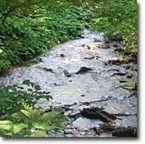
The conventional way of talking about rivers and tributaries is that they are "drainages," because they drain rain water from the land. Sadly, we can use the word literally for the Potomac tributaries that flow through the Gorge—pristine streams have become drainage ditches for moving rainfall from roofs and parking lots. There are two consequences of devastating effect on the Gorge’s tributaries. First is the problem of what the rainwater brings with it. In addition to all manner of lawn pesticides and chemical waste drawn from residential lawns and driveways, there is run-off from roadways. Chemical solvents, motor oil, snow-melting chemicals, and other known poisons are washed into tributary streams after every rain. A second, but less talked-about problem, is the way these huge volumes of water scour bare the river banks, removing vegetation and the life they support. Water carries sediments and sand—much of which was applied to roadways during winter snows—that are left behind to smother life forms. It is not just the amount of storm water running into streams that causes damage. It is the speed and force of water as it rushes through storm drains and plunges into small streams. The crushing blow down-cuts the stream bank, so that the stream bed is wider than the stream bank. This undercuts the bank and causes it to erode further, eventually collapsing into the stream and making the stream itself wider. In the Gorge area, healthy streams are cool, damp environments where mosses, ferns and wildflowers are apparent. Stream should teem with life, such as bugs, aquatic vegetation and small fish. They do when rainwater is allowed to slowly soak into the ground and bubble up through springs that feed the tributaries. In a healthy system, the increased stream flow from occasional heavy rains does not damage the stream. Unfortunately, local building codes and highway planning do not often consider the health of tributary streams. Parking lots, rooftops and ever-wider roadways mean more stress on the streams. Some streams now regularly experience flash flooding conditions that formerly occurred only rarely. In terms of engineering and landscaping, solutions to these problems are fairly simple. However, because old habits are tough to change, the solutions are difficult to enact. For example, although treating snowy roadways with salt, sand and chemicals is environmentally destructive, it is also cheapest way to make roads safe. There are more environmentally-friendly techniques, but not enough people have asked public officials to make them a priority. And there are many methods to manage stormwater, including easements that prevent construction close to stream banks and "living roofs" that soak up rainwater for plants. Some jurisdictions now require owners of giant parking lots to install underground holding tanks, so that rainwater run-off is released slowly over many days—a system that mimics natural groundwater infiltration. Because rain is such a symbol of life, it’s odd to think of rain as an environmental issue. However, we have altered the natural landscape outside the Gorge so much that the only way to restore life in its streams is to manage run-off from nature’s most basic gift: the rains. |
Last updated: April 10, 2015
